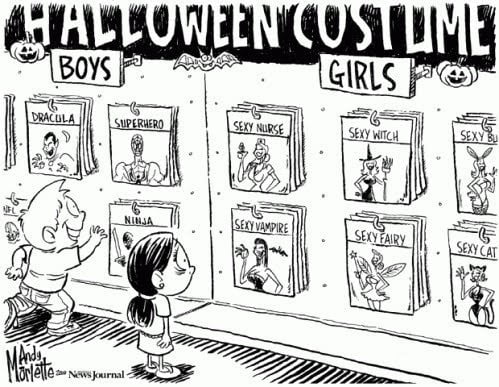The bias inherent in society that demarcates gender norms reaches the stage of harm at a certain peak: when you don’t see it anymore. Gender is not a binary, it is a fluid spectrum that comprises of an individual’s gender identity (which can correlate to a person’s biological sex assigned at birth or differ completely) and gender expression (their external attribution to their identity).
When there are norms of behaviour set out for the genders, there is a certain performance expected of the members of a society to fit into those rigid boundaries. Women having to wear a certain type of clothes, men having to be aggressive & manly, these are small parts of a larger puddle of expectations. This sort of socialization is where children, at a very early age, begin to imitate behaviour that is typically linked to their gender. From boys being “troublemakers” to girls being asked to “sit properly”, socialization teaches them to be the way their biological sex around them is.
These norms fluctuate from one place to another and are reinforced by multiple things that we are exposed to on a daily basis – advertisements, films, consumer products, etc. These are methods that consciously or tacitly reinforce these rules by telling the genders what to do, how to do it, and what is expected of them.
Advertisements, films, consumer products etc. reinforce gender ROLES by telling PEOPLE what to do AND how to behave.
When you see everybody around you behaving, dressing, and buying things a certain way, it becomes a deviation to be any different. Especially at a young age, sticking to these stereotypes becomes a way to gain acceptance in social groups and make friends. We learn to behave like those around us until we start naturally adhering to such behaviour: a vicious cycle propagated by the products, advertisements, and marketing that bandwagon the process along. What we are looking at here are agents of socialization, a script that players act along with willingly or forcefully.
Especially when it comes to clothing, a necessary part of our lives, boundaries serve to stifle a person’s ability to freely explore alternative gender identities and expressions. Given that a person’s gender expression is also comprised of how one physically represents oneself, clothing forms an important and necessary aspect of it. To be unable to alternate between gender expressions without feeling the walls of such boundaries pressing against you serves to gravely harm how comfortable a person would be with being open and accepted for their choices. They would then feel mocked/unsafe to go out into world and exhibit their gender expressions.
Here are some of the things we come across everyday that have been pointlessly gendered.
Clothes
While different sexes have different requirements for their bodies, this is no more about gender than it is about comfort. Sex and gender are not binaries, and neither should be our clothes. The fact that fashions are continually changing shows us that clothing is more a reflection of our culture that dictates its boundaries than a reflection of gender. Clothing was initially based on the shapes of the animal skins or fabrics it was fashioned from, the difference in clothing between men and women were minimal, if at all existent. Clothes have now moved from a matter of comfort to a matter of reinforcing your gender.
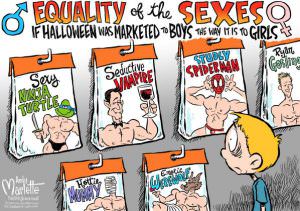
Andy Marlette
What we see in our current gender-confused, gender-strict, gender-biased world is that clothing has become a means to reinforce traditional gender identities and reflect representations that are already dominant in our society. While there are certain products that do need to be gendered based on differing requirements that men/women have (bras, boxers), there are other products that are not based on requirement so much as they are on stereotypes.
Women are to wear clothing that hugs their bodies and accentuates the sexualised portions of their bodies (breasts and butt). When we ask ourselves simple questions like why don’t women’s clothes have pockets as compared to men’s pockets that can carry a wallet, phone, and keys, we begin to realize that there is a true demarcation in the clothes the genders wear.
A woman’s clothing is often aimed at making her look attractive. The clothing a person wears deserves respect no matter what the choice. When women are called “boyish” for wearing loose clothing, or men are called “gay” for wearing tights and grooming themselves, it reinforces the idea that they have deviated form the norm, that they are violating the rules of dressing.

Adorna Shapewear (Left), Laceandme Tummy Tucker
Shapewear that aims at making a woman’s waist slim into the preferable hourglass figure showcase the ways in which women’s bodies are expected to look a certain way. Through advertisements and marketing, the ideal of a “perfect body” is constantly drilled into minds. The troubling idea of a tummy tucker, that a woman’s body must consist of straight lines and curves with nothing popping in or out is a worrying aspect of clothing.
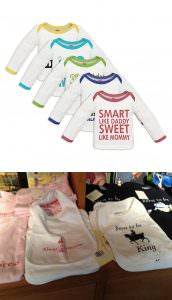
Amazon
Babies are not spared either. “Smart Like Daddy, Sweet Like Mommy”, says a baby’s outfit on Amazon. Pink for girls, blue/black for boys. A princess dress for girls, pullovers for boys. Children grow up with a rigid notion of what they should wear based on their gender, giving them no space to develop their gender identities and adopt their own gender expressions. What this serves to do is pressurize a child to perform as per their gender, an elaborate social performance that can only be broken with struggle and a vigorous rebellion.
Children grow up with rigid notionS of what they should wear based on their gender, ALLOWING no space to develop gender expressions.
Visual representations are paramount to brands and retailers to determine their market and capture it. These specific designs serve as a means to communicate an “ideal”. Marketing products then becomes about marketing the ideal to society and having them buy into it. Take sports shoes for example, while scrolling through Amazon’s shoes section, the most noticeable difference in shoes was that men’s shoes were never in pink. Women’s shoes had endless pages of pink shoes.

Brands are gradually beginning to make ungendered clothing, a vogue that we can see on runways as well. While this progress is gradually picking up, the day a man can wear a saree and confidently walk around a crowded street in India without being stared down is the day we have broken the subtle pink gender glass ceiling.
Jewelry and Makeup
Self-ornamentation is a method of expressing identity. Men in tiaras with long earrings and jhumkis is a scenario that is out of the ordinary. It is only is certain cultural contexts that men wear earrings, but even in those scenarios, they are studs (tiny earrings), not the long, elegant ones available often to women.
It also brings to light the fact that the larger consumers of this product are women, not men. Make-up is a choice, one that is freely and readily available to those who choose to use it. Yet, how often would we see a man walking down the street with bright red lipstick, mascara, and a Bindi without giving him a second look?
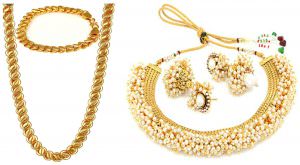
Charm’s Men’s Jewelry (Left) Youbella Women’s Jewelry (Right)
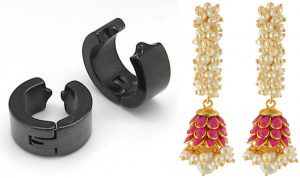
Chandrika Pearls Men’s Earrings (Left) Rajasthani Tradition Women’s Earrings (Right)
Also read: Feminism and Makeup: Do They Go Hand in Hand?
Watches
Do men and women look at time differently? This is a question that plagues me often while cruising through the Fastrack or Quartz show rooms in India. Women’s watches often have miniature dials, delicate, adorned with jewelry. Men’s watches are made thick, with big dials, thick straps, metallic embodiment. While women may have smaller wrists as compared to that of men and that would require a different design, especially of the dial, it still begs to question why women’s watches are made more dainty, looking pretty. While men’s watches are made to look “manly” and tough.
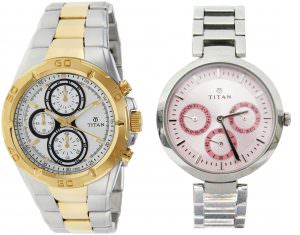
Titan Men’s Watch (Left) Titan Women’s Watch (Right)
Toys
Monster trucks for boys, barbie dolls for girls. A search for “toys for boys” brings up images to trucks, trains, transformers, swords, pokemons (including certain (thankfully) ungendered products like legos). A search for “toys for girls” throws up a plethora of curious images: of beauty kits, kitchen sets, dolls, barbies, nail art. The pages are alarmingly pink, it should be added.

Premsons Train Kit for Boys (Left) Saffire Beauty Kit Toy for Girls (Right)
This chisels and grinds children into the gender roles are expected to occupy, carrying forward the burdens thrust upon them through generations of conditioning. Additionally, toys targeted at girls are meant to make them more nurturing (e.g. kitchen sets) and delicate, whereas the toys given to boys promote motor skills and solitary play.
Kinder Joys recently released Pink Kinder Joys for little girls and Blue Kinder Joys for little boys, underlying the notion pink is a “girly” colour and blue is meant for boys. The sheer ludicrousness of having segregated Kinder Joys for boys/girls shows how far marketers are willing to go to expand their base. It is a given that the toys to be contained in each egg were to be different. The blue ones were to have toy cars, while the pink one was to have dolls (Ferrero Statement). Not only does this directly tell a child what colour is to be associated with the genders, it tries to indicate the type of toys they are supposed to want and be playing with.
Different toys also enhance and teach certain behaviours and skills, such as delicacy, caring for looks, and tenderness – most of which are targeted at girls. When constantly subjected to such conditioning from all ends, it is grilled into a child’s mind how s/he should be, leaving no scope for discovery. It becomes even harder for them to then make the decision to switch/try alternative genders because of their exposure to such segregation from early childhood, making them skeptical and dubious as to how people around them will receive their change.
Perfume
It is true that every person smells different, let alone sex pheromones and odours released by the different sexes. However, the manner in which perfumes have been marketed is the questionable aspect. Take the typical Axe ad (among others) where the man sprays the perfume and women smell the aroma of virility and come running towards the now transformed male. Juxtapose this with ads of perfumes for women, which often tell them how they will smell like a basket of roses, that are more often than not based on the ability of the perfume to seduce, to smell as attractive as possible. What this tries to convey is that the primary goal for men should be to “score” as many women as possible, and for women to always be seductive enough for men to “capture”.

Axe Perfume Ads
Hopefully, we are moving to a society where it is acceptable for all the genders to harness this means of expression of their own will, without being shunned for it, or called “effeminate” or “girly”/”tomboy” or “boyish” for having made the choice. When the agency of a person is removed from the equation and it becomes a norm that is enforced on an individual’s conscience, it becomes an institutional harm. Choices, though, have come to be intrinsically gendered.
These are few among a melange of gendered products available all around us, we need only open our eyes to them. Manufacturers capitalize on gender to sell their products, a dangerous idea when it begins to set itself into strict lines in our minds. The obsessive culture of consumerism is one that makes & breaks binaries, and as the consumers who are in its direct line of fire, its time we extinguish the flames and identify the ash behind it.
Further Reading
- Pointlessly Gendered Products
- Indian Essentials, Penguin Books
- The Gendered Object, Pat Kirkham
- Gender And Jewelry: A Feminist Analysis, Rebecca Ross Russell
- Socialization to Gender Roles: Popularity among Elementary School Boys and Girls, American Psychological Association Publication
About the author(s)
Shilpa Prasad is a law student who loves books, poetry and her guitar.
